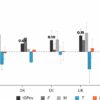Lower-to-middle-income countries still struggle with high unemployment rates after COVID-19 lockdowns and economic restrictions, unlike higher-income countries such as Canada, finds a new study led by York University with the University of Witwatersrand in Johannesburg.
This is opposite from the 2008–2009 global economic crisis when higher-income countries suffered more from the recession than lower-income countries.
The study used Twitter sentiments to help compare macroeconomic factors including unemployment and inflation across Nigeria, South Africa and Canada representing lower-middle, upper-middle and high-income countries respectively.
They found the unemployment rate increased for all three countries at the beginning of the pandemic, however, Canada was able to control the rate after the first couple of months unlike Nigeria and South Africa, where they continue to struggle with high unemployment.
“This indicates how vulnerable lower-middle income countries are to lockdowns and economic limitations, bearing a greater loss during the COVID-19 pandemic than higher income countries,” says York University Assistant Professor Jude Kong, the study’s corresponding author and director of the Africa-Canada AI & Data Innovation Consortium (ACADIC).
Before COVID-19, lockdowns and economic restrictions, Nigeria’s unemployment rate was lower than South Africa’s, while the inflation rate of South Africa was lower than Nigeria. During the pandemic, however, unemployment and inflation rates in Nigeria have increased more than Canada and South Africa.
Now the inflation rate is increasing in all three, especially in Canada and Nigeria, which has experienced both high unemployment and high inflation throughout the pandemic.
“The COVID-19 crisis has affected all income country groups. The burden, however, is much heavier on lower income classes. Coming back from this complexity will be difficult, especially for middle-income countries,” says study co-author Professor Bruce Mellado, member of the Gauteng Premier COVID-19 Advisory Committee in charge of modeling from the University of Witwatersrand and iThemba LABS in South Africa and co-president of ACADIC. Gauteng is the most populous province in South Africa and hosts Johannesburg and Pretoria.
“The management of the COVID-19 pandemic taught us about the importance of data to enact evidence-based decisions. The way policymakers view data has changed greatly as a result. We are looking forward to the use of more data in dealing with societal problems,” says Mduduzi Mbada, acting director general of the Gauteng Province.
Although South Africa’s inflation rate is still comparable to pre-pandemic levels, any policies put in place to deal with high unemployment are expected to increase the inflation rate. Canada’s unemployment rate remains good, but it is now seeing it is highest inflation rate in 15 years, which may have been brought on in part by the decision to provide the Canada Emergency Response Benefit and Employment Insurance to the employees who lost their jobs because of COVID-19.
Part of what makes this study unique is the authors use of different machine learning algorithms to estimate the monthly unemployment rates for Nigeria and South Africa using unconventional data such as Twitter sentiment and Google Trends data. Monthly inflation data was available for all three countries, but not monthly unemployment data for South Africa and Nigeria.
Social media and social networks, such as Facebook, Twitter, LinkedIn, Instagram, Snapchat, Pinterest, and Reddit, are filled with real-time information, which is stored electronically and often accessible.
“They are well-posed to revolutionize the manner and the speed at which especially difficult to get infectious disease data is made available,” says Kong. “Data used to inform infectious disease models usually comes from classical surveillance systems, but they suffer from several shortcomings, including severe time lags and a lack of spatial resolution. They are also costly.”
Data from country-specific Twitter can be used to better understand concerns and sentiments around the macroeconomic situations at the local level—potentially leading to more targeted and publicly acceptable policies based on social media content.
“Social media can also provide data on behaviors and outcomes related to vaccine or drug use, including drug-related adverse events, complementing conventional vaccine and pharmaco-vigilance approaches, in which the tracking of vaccine- and drug-related adverse events mainly relies on passive reporting by physicians,” says Mellado.
Their richness in text-based data in the form of posts and comments allows researchers to identify popular topics and assess public sentiment. This can help inform decision-makers and policymakers and allow for a better understanding of concerns and worries about macroeconomics at the local level.
The paper was published today in the journal PLOS ONE.
More information:
Zahra Movahedi Nia et al, A cross-country analysis of macroeconomic responses to COVID-19 pandemic using Twitter sentiments, PLOS ONE (2022). DOI: 10.1371/journal.pone.0272208
Citation:
Twitter shows lower-to-middle income countries have higher unemployment post pandemic (2022, August 24)



